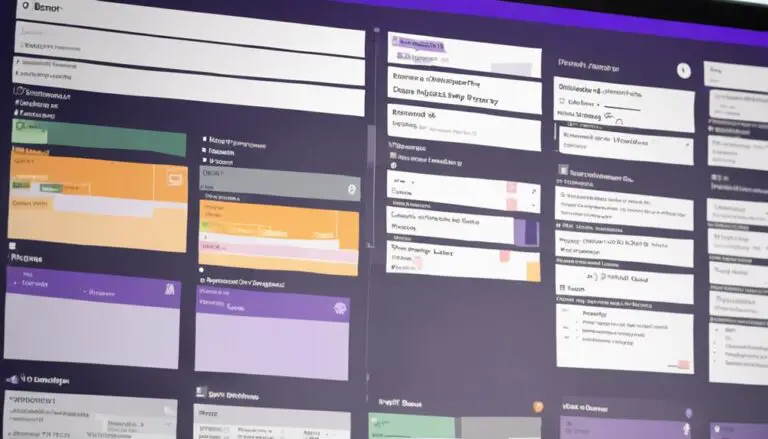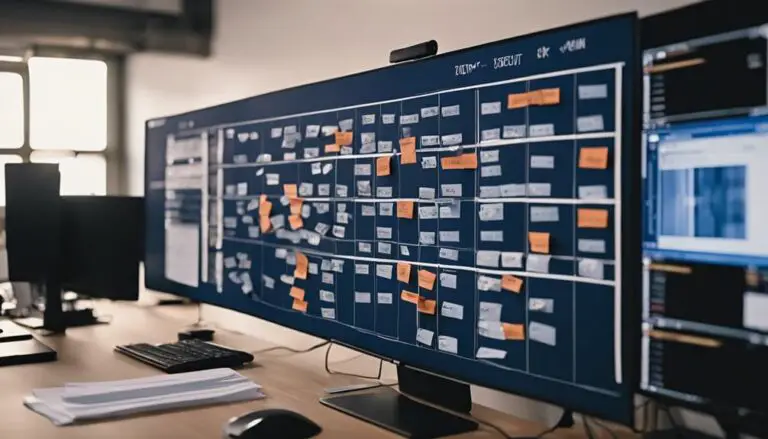'Rome wasn't built in a day,' and similarly, effectively estimating velocity for Kanban teams requires a strategic approach and the right tools.
By understanding how Kanban teams estimate their velocity, you can improve workflow, predict completion rates, and optimize team performance.
But what methods and techniques do these teams use to ensure accurate velocity predictions and enhance productivity?
Let's explore the practical strategies and tools that empower Kanban teams to estimate their velocity effectively, leading to successful project deliveries and improved efficiency.
Key Takeaways
- Utilize Kanban boards for visual tracking of work progress.
- Analyze historical velocity data to refine estimation processes.
- Compare estimated velocity with actual velocity for continuous improvement.
- Adapt processes based on velocity analysis to optimize workflow efficiency.
Importance of Velocity Estimation
Understanding the importance of velocity estimation is key to enhancing your Kanban team's efficiency and productivity.
By estimating velocity, your team can gauge its capacity for completing work in a given timeframe. This estimation allows you to predict how many tasks your team can accomplish based on past performance, aiding in setting realistic goals and managing stakeholder expectations effectively.
Predicting velocity helps your team plan future work more accurately, ensuring a smoother workflow and improved overall performance. Through tracking velocity, your team can identify trends, make data-driven decisions, and continuously improve its processes.
This data-driven approach not only optimizes your team's performance but also fosters a culture of collaboration and adaptability within your Kanban team. Embracing velocity estimation is a crucial step towards achieving operational excellence and delivering value consistently.
Factors Affecting Velocity Prediction
To enhance your Kanban team's velocity prediction accuracy, consider the various factors that can influence the estimation process.
Team composition plays a crucial role, as diverse skill levels and availability impact how work is approached and completed. Historical data provides valuable insights into past performance, while understanding the variability in task complexity helps in making more accurate predictions.
External dependencies and interruptions can disrupt workflow, affecting the team's ability to deliver as expected. Changes in team dynamics also play a part in the predictability of velocity.
Effective communication and collaboration among team members foster a shared understanding, leading to more reliable velocity predictions. By holding regular retrospective meetings, implementing feedback loops, and continuously improving practices, your team can refine its velocity estimation over time.
Stay mindful of these factors to enhance your team's ability to predict velocity effectively.
Best Practices for Velocity Estimation
For improved velocity estimation accuracy, incorporate these proven best practices into your Kanban team's workflow.
Begin by considering your team size when estimating velocity, as larger teams may handle more work but could also face coordination challenges.
Track completed work items consistently to measure team velocity effectively.
Utilize metrics such as cycle time and throughput to gain insights into your team's continuous flow of work.
Historical velocity data offers valuable benchmarks for future estimation, so ensure you regularly update and analyze this information.
Comparing estimated velocity with actual velocity helps fine-tune your estimation process over time.
Remember, accurate velocity estimation is key to forecasting project timelines and planning upcoming work efficiently.
Tools for Tracking Team Velocity
Consider implementing Kanban boards, Burndown Charts, and Cumulative Flow Diagrams as vital tools for tracking your team's velocity and enhancing overall performance. These tools play a crucial role in helping Kanban teams analyze their performance, identify bottlenecks, and streamline workflow processes effectively.
Here are some key points to keep in mind:
- Kanban boards: Visual representation of work items helps in real-time tracking of team progress.
- Burndown Charts: Predict completion times based on historical data, aiding in project planning and delivery forecasting.
- Cumulative Flow Diagrams: Provide insights into project flow metrics, enabling teams to analyze cycle times and optimize processes.
Enhanced performance: Utilizing these tools can lead to a better understanding of team velocity, facilitating continuous improvement and boosting overall productivity.
Adjusting Velocity for Continuous Improvement
Let's focus on how to refine velocity tracking methods and analyze performance iteratively.
By adjusting velocity based on these insights, you can enhance your team's productivity and overall efficiency.
Iterative improvements are key to continuously refining your processes and achieving better outcomes.
Velocity Tracking Methods
To enhance your Kanban team's performance and make informed decisions, track velocity by measuring completed work items in each sprint. Here are some practical tips for adjusting velocity to drive continuous improvement:
- Regularly review completed work items to refine your velocity tracking.
- Collaborate with team members to analyze variances and identify areas for improvement.
- Use historical data to adjust velocity for more accurate future estimations.
- Adapt your velocity tracking methods based on feedback and changing team dynamics.
Iterative Performance Analysis
Enhance your Kanban team's performance through iterative analysis of velocity adjustments for continuous improvement. By utilizing historical data and team performance metrics, you can refine velocity estimates to optimize future sprints.
Continuous improvement is key, and making adjustments based on completed work items and team capacity allows for a more accurate forecast. Iterative performance analysis enables your team to adapt and enhance their workflow over time, leading to improved overall efficiency.
Challenges in Velocity Estimation
Navigating the landscape of velocity estimation in Kanban teams presents a myriad of challenges, often stemming from the dynamic nature of task sizes and unforeseen interruptions. When it comes to estimating velocity effectively, you may encounter the following hurdles:
- Task Size Variability: The fluctuating sizes of tasks on the Kanban board can make it tricky to gauge how many items can be completed within a certain timeframe.
- Team Composition Changes: Alterations in team members' skill levels or the addition of new team members can influence the team's overall productivity and impact velocity estimation accuracy.
- Unforeseen Interruptions: Unexpected disruptions or external dependencies can throw off the team's progress, making it harder to predict how quickly tasks can be completed.
- Lack of Historical Data: Without past performance metrics or experience with Kanban, determining a reliable velocity estimate can be challenging.
Overcoming these challenges requires adaptability and continuous improvement in your estimation techniques to enhance the predictability of your team's velocity.
Real-Life Applications of Velocity Analysis
Let's explore how velocity analysis can be practically applied in Kanban teams.
By understanding your team's velocity in planning, you can make more accurate estimations for project delivery times.
Additionally, comparing performance metrics based on velocity data allows for continuous improvement strategies to enhance workflow efficiency.
Velocity in Planning
To effectively plan project timelines, understanding and leveraging velocity in Kanban teams is crucial for predicting future productivity and setting realistic expectations. When considering velocity in planning, keep in mind the following:
- Estimate project timelines accurately by analyzing past velocity trends.
- Use velocity to determine the team's capacity and adjust workload accordingly.
- Enhance productivity by aligning work items with the team's estimated velocity.
- Improve planning accuracy by incorporating velocity data into sprint and release planning sessions.
Performance Metrics Comparison
When comparing performance metrics through velocity analysis in Kanban teams, you gain valuable insights into your team's efficiency and future work capacity. By examining velocity data, you can predict future capacity, optimize workflow, and allocate resources effectively.
Understanding your team's productivity through velocity metrics allows for better planning and decision-making. Analyzing velocity trends enables you to identify bottlenecks, improve workflow processes, and enhance overall performance.
Comparing velocity across different time periods helps track progress, set realistic goals, and drive continuous improvement. Utilizing velocity analysis not only enhances team performance but also fosters a culture of collaboration and belonging within your Kanban team.
Make the most of these insights to achieve optimal results in your projects.
Continuous Improvement Strategies
Analyzing velocity data in Kanban teams offers actionable insights for implementing continuous improvement strategies and enhancing overall performance.
- Enhancing Estimation Accuracy: Utilize velocity data to refine estimation processes and make more accurate predictions.
- Improving Delivery Timelines: Track velocity trends to streamline workflows and meet deadlines more efficiently.
- Optimizing Workflow: Adapt processes based on velocity analysis to eliminate bottlenecks and enhance overall efficiency.
- Making Data-Driven Decisions: Use velocity data to inform strategic planning, set achievable goals, and drive continuous improvement initiatives.
Frequently Asked Questions
How Do Kanban Teams Estimate Their Velocity?
To estimate their velocity effectively, Kanban teams rely on estimation techniques, cycle time, throughput metrics, and forecasting accuracy. By using story points, capacity planning, and continuous improvement, teams can set realistic goals and enhance productivity.
Can You Track Velocity in Kanban?
You can definitely track velocity in Kanban! It's a vital metric for understanding team progress, identifying bottlenecks, and making informed decisions. Monitoring velocity helps you gauge performance, plan capacity, and enhance efficiency.
How Can We Measure the Performance of the Team Using Kanban?
To measure the performance of your team using Kanban, focus on performance metrics, team productivity, agile practices, data analysis, process improvement, work efficiency, and task completion. These aspects will help you track progress effectively.
How Do You Measure Team Velocity?
To measure team velocity effectively, track completed tasks per iteration. Analyze velocity metrics for forecast accuracy and capacity planning. Focus on continuous improvement by monitoring cycle time, lead time, and throughput analysis. Stay agile and collaborative.
Conclusion
As you navigate the complexities of estimating velocity in Kanban teams, remember that the key lies in embracing continuous improvement. Like a skilled sailor adjusting their course in response to changing winds, your team must be flexible and adaptive.
By utilizing the right tools, setting WIP limits, and analyzing data effectively, you can steer towards success and navigate through any challenges that come your way.
Keep sailing towards your goals with confidence and determination.





